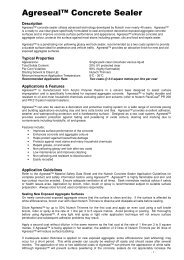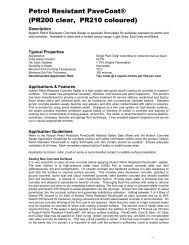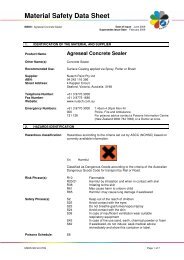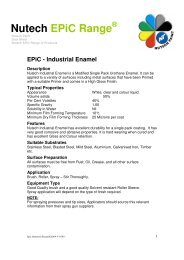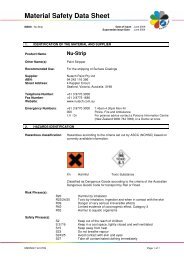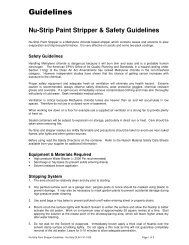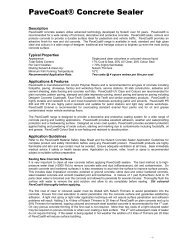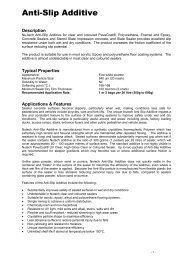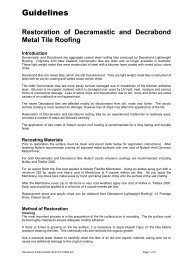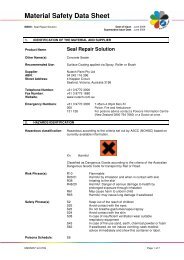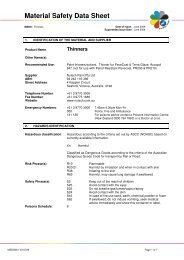Nutech Aqua Glaze Data Sheet
Nutech Aqua Glaze Data Sheet
Nutech Aqua Glaze Data Sheet
- TAGS
- nutech
- aqua
- glaze
- sheet
- westflex.com.au
You also want an ePaper? Increase the reach of your titles
YUMPU automatically turns print PDFs into web optimized ePapers that Google loves.
<strong>Aqua</strong> <strong>Glaze</strong> Concrete Sealer<br />
Application Guidelines<br />
Application by broom, roller, brush or spray is recommended, subject to suitable surface preparation.<br />
Sealing New Concrete Surfaces<br />
It is very important to clean all new concrete before applying <strong>Aqua</strong> <strong>Glaze</strong> Concrete Sealer sealers. The best<br />
method is to high pressure water blast (>2000 Psi) to remove concrete salts and dust (efflorescence), dirt<br />
and contamination. On smooth concrete and hardened surfaces it is also necessary to acid etch the surface<br />
to improve surface porosity. This includes slate impression concrete, polished or ground concrete, stone<br />
dust and colour hardened concrete, steel trowelled concrete and smooth trowelled joint and border lines. A<br />
mixture of 1 part Hydrochloric Acid to 15 parts clean water is broomed over the concrete and allowed to<br />
penetrate for several minutes. Thoroughly flush the surface with water to remove the acid solution and allow<br />
to dry completely before sealing. Ensure first coat saturation to assist penetration into the concrete surface<br />
and guarantee satisfactory adhesion. No thinning is required for first or subsequent coats. More than two<br />
coats of a light coloured sealer may be required on concrete or when over coating a darker surface. In<br />
winter concrete is usually cold and wet on the surface for at least 2-3 days and sometimes for up to one<br />
week. Sealing of this concrete is not recommended until the surface has started to whiten indicating<br />
adequate curing. If inadequate sealer thickness is applied on new concrete, some efflorescence (salt<br />
whitening) may occur for a short period. This white powder can usually be washed off easily and should<br />
cease after several months. The application of one or two additional coats of sealer can prevent the<br />
appearance of white salts. Although <strong>Aqua</strong> <strong>Glaze</strong> Concrete Sealer will prevent surface powdering of the<br />
concrete, sealers do not appreciably increase the hardness of the concrete surface. Soft or damaged<br />
concrete should not be sealed with <strong>Aqua</strong> <strong>Glaze</strong> Concrete Sealer without special surface treatment to<br />
stabilise and harden the concrete.<br />
Sealing & Resealing Old Concrete<br />
It is important to remove all grease, oil, food, contamination and flaking paint before sealing or re-sealing.<br />
<strong>Nutech</strong> Grease Magic should be used to remove oil and grease. Soaking heavy stains with Grease Magic<br />
before high pressure water cleaning is recommended. All cleaners, chewing gum, food, silicon and acrylic<br />
paint should be completely removed from the concrete before <strong>Aqua</strong> <strong>Glaze</strong> Concrete Sealer is applied.<br />
Thorough testing is recommended before applying <strong>Aqua</strong> <strong>Glaze</strong> Concrete Sealer over a previously sealed<br />
surface to ensure compatibility. Before applying <strong>Aqua</strong> <strong>Glaze</strong> Concrete Sealer do not acid etch the concrete<br />
if there is an existing sealer or coating on the surface because coating delamination will occur. Very old,<br />
hard sealer or problem and delaminating sealer surfaces should be thoroughly scrubbed with <strong>Nutech</strong> Seal<br />
Repair Solution before re-sealing (refer SRS application instructions). It is recommended that a small area is<br />
tested using this method and left to weather for at least 4-6 weeks. If the new sealer on the test area fails,<br />
stripping the old sealer, acid etching and high pressure water cleaning will be required before applying new<br />
coats of <strong>Aqua</strong> <strong>Glaze</strong> Concrete Sealer .<br />
Slip Hazard<br />
Sealing of smooth and sloping concrete surfaces will reduce pedestrian and vehicle safety. Adding one or<br />
two 300gram packets of <strong>Nutech</strong> Anti-Slip Additive per 20 litres in the final coat of <strong>Aqua</strong> <strong>Glaze</strong> Concrete<br />
Sealer will reduce slipping and improve pedestrian safety. <strong>Nutech</strong> Anti-Slip Additive is not adequate on<br />
steep concrete therefore <strong>Aqua</strong> <strong>Glaze</strong> Concrete Sealer is not recommended for sealing very steep and<br />
smooth concrete. Refer to your <strong>Nutech</strong> specialist for alternative coating recommendations on steep smooth<br />
surfaces.<br />
Important Note<br />
The information given on this data sheet is based on many years experience and is correct to the best of our knowledge. However<br />
since the use of our product, surface conditions, weather and a number of other factors are completely beyond our control, we can only<br />
be responsible for the quality of our product at the time of dispatch. For more information please contact our Company. As this<br />
information is of a general nature, we cannot assume any responsibility in individual cases.<br />
<strong>Aqua</strong> <strong>Glaze</strong> CS NTDSO43-V1-0802.DOC<br />
- 2 -



